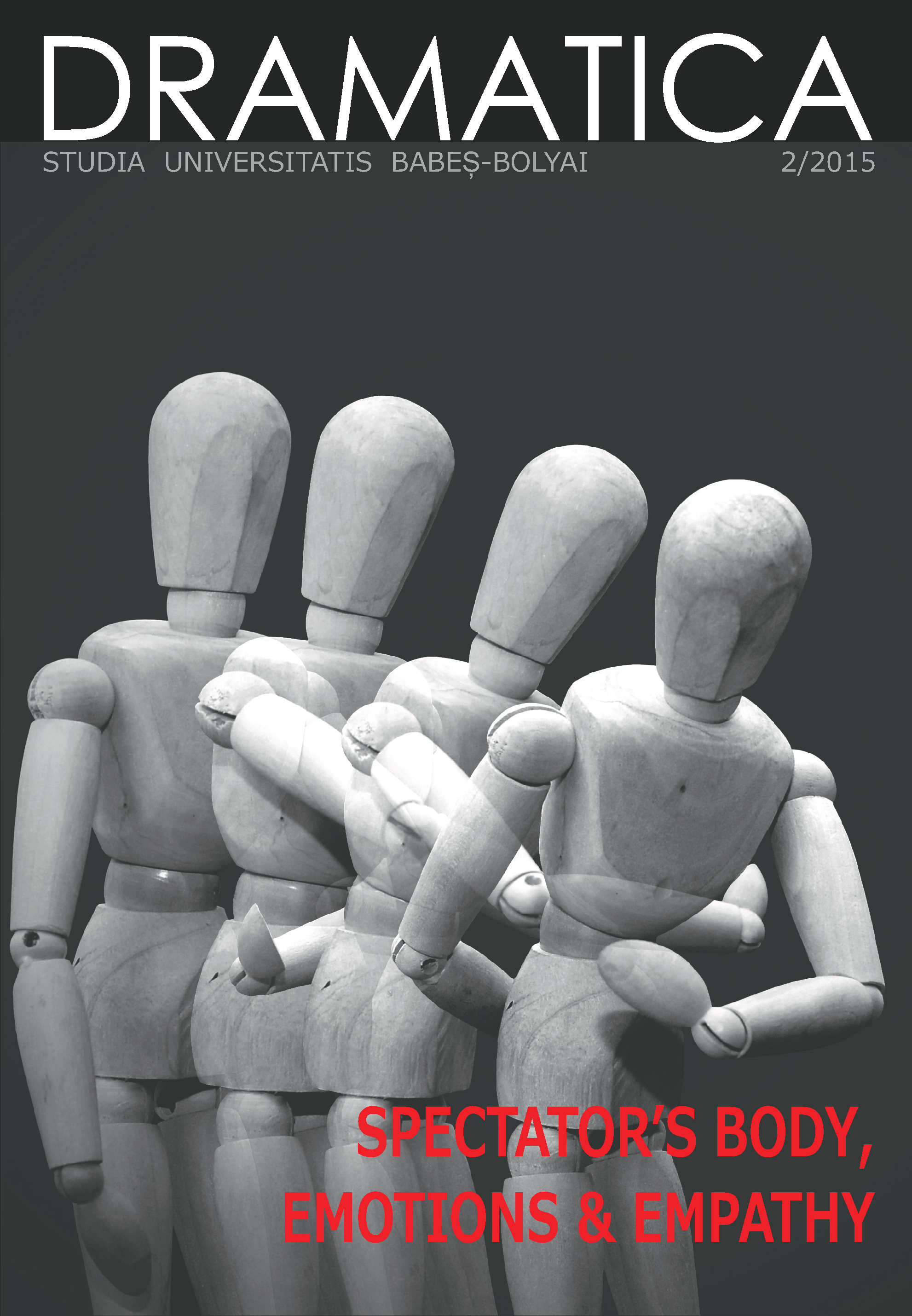Strategies for the Embodiment and Disembodiment of Spectatorship: “Don’t Cry Baby” and “Hotel” by Eugen Jebeleanu
Keywords:
Spectatorship, Theatre, Performing Arts, Body Perception, Audience Response, NeurosciencesAbstract
This paper will emphasize a series of negotiation and renegotiation strategies for the corporeal-cognitive relationship between the actor and the spectator in contemporary experimental theatre. To this end, I have chosen two performances with totally different narrative and performative structures (a verbal one and a nonverbal one both staged by the same director, Eugen Jebeleanu and his team Compagnie 28: Don’t Cry Baby, a play by Catinca Drăgănescu, based on the typologies/situations in Charles Perrault’s Little Red Riding Hood, and Hotel, a free adaptation on F.X. Kroetz’s Wunschkonzert. The paper mixes the descriptive analysis of Jebeleanu’s performances with theoretical and applied perspectives from the fields of cognitive psychology and neurosciences, as well as of semiotics and pragmatics. The hypothesis I am trying to verify is that experimental shows performed in small spaces combine the corporeal-empathic and the cognitive challenges exerted on the spectator, sometimes turning the experience of the latter into a participatory game that involves an enhancement of one's proprioceptive internal sensations, a stronger perception of one's own body being alive and a participatory attendance.
References
ANTUNES, Luis Rocha, 2012, "The Vestibular in Film: Orientation and Balance in Gus Van Sant’s Cinema of Walking," Essays in Philosophy: Vol. 13: Iss. 2
BERTHOZ, Alain, 2000, The Brain’s Sense of Movement, translated by Giselle Weis, Cambridge, MA, Harvard University Press
BERLUCCHI, Giovanni; Aglioti, Salvatore M., 2009, „The body in the brain revisited”, Expanded Brain Research, Springer-Verlag, p. 25-35
CARROLL, Nöel, 1988, Mystifying Movies: Fads and Fallacies in Contemporary Film Theory, New York, Columbia University Press
De CERTEAU, M., 1984, The Practice of Everyday Life, Berkeley, Los Angeles and London, University of California Press
ESROCK, Ellen J., 2010, Embodying Art: The Spectator and the Inner Body, Poetics Today, 31:2
FENEMORE, Anna, 2007, „On Objects’ The Pleasure of Objectification: A Spectator’s Guide”, Performance Research Vol. 12, No. 4
FISHER-LICHTE, Erika, 1992. The Semiotics of Theatre, Bloomington, Indiana University Press
FISHER-LICHTE, Erika, 2008. ”Sense and Sensation: Exploring the Interplay between the Semiotic and Performative Dimensions of Theatre”, Journal of Dramatic Theory and Criticism, Vol XXII, no 2
FREEDBERG, David; Gallese, Vittorio, 2007, „Motion, emotion and empathy in esthetic experience”, TRENDS in Cognitive Sciences, Vol.11, No.5
Gal RAZ; Yael Jacob; Tal Gonen; Yonatan Winetraub; Tamar Flash; Eyal SOREQ; and Talma Hendler, 2013, „Cry for her or cry with her: context-dependent dissociation of two modes of cinematic empathy reflected in network cohesion dynamics”, Social Cognitive and Affective Neurosciences, (7) 2013, p. 30-41
KENNEDY, Denis, The Spectator and the Spectacle. Audiences in Modernity and Postmodernity, Cambridge University Press
MARKS, Laura, 2002, Touch: Sensuous Theory and Multisensory Media, University of Minnesota Press
SMITH, Murray, 1995, Engaging Characters. Fiction, Emotion, and the Cinema, Oxford University Press
Downloads
Published
How to Cite
Issue
Section
License
Copyright (c) 2015 Studia Universitatis Babeș-Bolyai Dramatica

This work is licensed under a Creative Commons Attribution-NonCommercial-NoDerivatives 4.0 International License.


